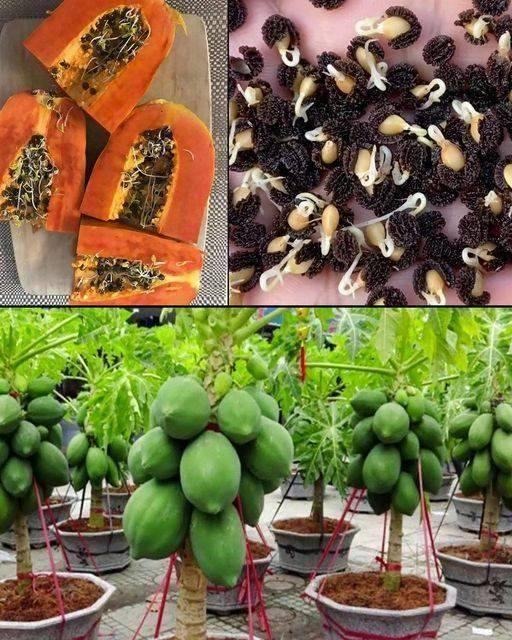Growing papaya at home in pots offers the advantage of control over environmental conditions, but it also requires attention to detail for success. When selecting a pot, opt for one made of breathable material like terracotta to promote air circulation to the roots. Ensure the pot has sufficient drainage holes to prevent water accumulation, which can lead to root rot.
For the potting mix, consider adding organic compost or aged manure to enrich the soil with nutrients. A pH-balanced mix is ideal, as papaya plants prefer slightly acidic to neutral soil conditions. Additionally, adding a layer of mulch on top of the soil can help retain moisture and regulate soil temperature, creating a conducive environment for papaya growth.
When planting seeds or seedlings, space them adequately to allow for proper root development. Papaya plants have shallow roots, so avoid overcrowding to prevent competition for nutrients and space. It’s also beneficial to add a layer of organic mulch around the base of the plants to suppress weed growth and retain soil moisture.
In terms of watering, papaya plants prefer consistent moisture levels but can be sensitive to overwatering. Monitor soil moisture regularly, adjusting your watering schedule based on environmental conditions such as temperature and humidity. During periods of active growth or fruiting, papaya plants may require more frequent watering to support their increased water needs.
Fertilization is key to promoting healthy growth and fruit production in papaya plants. Consider using a balanced fertilizer with a higher potassium content to support flower and fruit development. Apply fertilizer according to the manufacturer’s recommendations, avoiding excessive nitrogen, which can lead to lush foliage growth at the expense of fruit production.
Regular pruning is essential for maintaining the health and vigor of papaya plants grown in pots. Remove any dead, damaged, or diseased leaves promptly to prevent the spread of pathogens. Additionally, thinning out excess growth can improve air circulation and light penetration, leading to healthier plants and better fruit production.
By paying attention to these details and providing proper care, you can successfully grow papaya plants in pots, enjoying a steady supply of fresh, home-grown fruits throughout the growing season.
To further enhance the success of growing papaya in pots, consider implementing additional practices such as pollination assistance and occasional pest control measures. Papaya plants are typically dioecious, meaning they have separate male and female flowers on different plants. To ensure fruit set, consider planting multiple papaya plants or introducing pollinators like bees to aid in the pollination process. Alternatively, you can manually transfer pollen from male to female flowers using a small brush or cotton swab.
Furthermore, papaya plants can be susceptible to certain pests and diseases, especially in indoor or greenhouse environments. Keep a close eye on your plants for signs of pest infestations such as aphids, mealybugs, or scale insects. You can use natural remedies like neem oil or insecticidal soap to control minor pest issues. For more severe infestations or disease outbreaks, consider consulting with a local gardening expert or extension service for appropriate treatment options.
Additionally, providing support for heavy fruit clusters can help prevent branches from breaking under the weight of mature papayas. You can use soft ties or slings to support the fruit as they develop, especially during periods of rapid growth or inclement weather. Regularly inspect the supports to ensure they are secure and adjust them as needed to accommodate the growing fruit.
Lastly, monitor the overall health and vigor of your papaya plants regularly. Look for any signs of nutrient deficiencies such as yellowing leaves or stunted growth, which may indicate the need for additional fertilization or soil amendments. Addressing any issues promptly can help maintain the productivity and longevity of your papaya plants, ensuring a continuous harvest of delicious fruits for years to come.

Growing Papaya At Home In Pots
- Selecting the Right Variety: Choose a papaya variety that is suitable for container gardening. Dwarf or miniature varieties are typically better suited for pots as they have a more compact growth habit.
- Choosing a Pot: Select a large pot with a diameter of at least 20-24 inches and a depth of 20-24 inches. Make sure the pot has drainage holes at the bottom to prevent waterlogging.
- Potting Mix: Use a well-draining potting mix that is rich in organic matter. You can mix equal parts of garden soil, compost, and perlite or sand to create a suitable growing medium.
- Planting Seeds or Seedlings: You can start papaya plants from seeds or purchase seedlings from a nursery. If starting from seeds, plant them directly into the pot at a depth of about 1 inch. If using seedlings, carefully transplant them into the center of the pot.
- Location: Place the pot in a sunny location where the plant will receive at least 6-8 hours of direct sunlight daily. Papayas thrive in warm temperatures, so ensure the plant is protected from cold drafts or frost.
- Watering: Water the papaya regularly to keep the soil consistently moist but not waterlogged. Allow the top inch of soil to dry out slightly between waterings. Avoid overwatering, as this can lead to root rot.
- Fertilizing: Papaya plants are heavy feeders and will benefit from regular fertilization. Use a balanced fertilizer or a fertilizer specifically formulated for fruiting plants. Follow the instructions on the fertilizer package for application rates.
- Pruning: Remove any dead or damaged leaves and prune the plant to maintain its shape and encourage healthy growth. You can also remove any suckers that emerge at the base of the plant to focus energy on fruit production.
- Support: As the papaya plant grows, it may need support to prevent it from toppling over. You can use stakes or a trellis to provide support, especially if you live in a windy area.
- Pest and Disease Control: Keep an eye out for common pests such as aphids, whiteflies, and spider mites, and treat them promptly with insecticidal soap or neem oil. Also, watch for signs of diseases such as powdery mildew or leaf spot, and take appropriate measures to control them.


